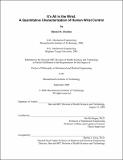| dc.contributor.advisor | Neville Hogan. | en_US |
| dc.contributor.author | Charles, Steven Knight | en_US |
| dc.contributor.other | Harvard University--MIT Division of Health Sciences and Technology. | en_US |
| dc.date.accessioned | 2009-06-25T20:35:26Z | |
| dc.date.available | 2009-06-25T20:35:26Z | |
| dc.date.copyright | 2008 | en_US |
| dc.date.issued | 2008 | en_US |
| dc.identifier.uri | http://hdl.handle.net/1721.1/45623 | |
| dc.description | Thesis (Ph. D.)--Harvard-MIT Division of Health Sciences and Technology, 2008. | en_US |
| dc.description | This electronic version was submitted by the student author. The certified thesis is available in the Institute Archives and Special Collections. | en_US |
| dc.description | Includes bibliographical references (p. 173-178). | en_US |
| dc.description.abstract | Over the past three decades, much research in motor neuroscience has focused on understanding how humans make coordinated reaching movements, yielding valuable insight into the planning and control of reaching movements, and establishing a foundation for robot-assisted rehabilitation. The goal of this doctoral research was to provide a quantitative characterization of humans' wrist rotations, paving the way for intelligent robot-assisted wrist rehabilitation. More specifically, we have characterized the kinematics, dynamics, and adaptation of wrist rotations, and discussed implications for planning and control. Kinematics: It is well known that humans make relatively straight reaching movements, suggesting that reaching movements are primarily under kinematic control of hand position. We used a motion capture system to test if wrist rotations are also under kinematic control. We found that wrist rotations exhibit a pattern with significantly more path curvature and variability than reaching movements (p = 0.001). While the increased path curvature could indicate that wrist rotations are not under kinematic control, this work provides evidence that the curvature is instead due to imperfect peripheral execution.Dynamics: In order to determine the exact cause of path curvature, an anatomically-accurate, mathematical model of the wrist was developed, including recent measurements of passive wrist stiffness. Combining experimentally-measured kinematics from human subjects with the wrist model revealed that moderately-sized wrist rotations can be approximated by a very simple model with virtually no loss in accuracy.Interaction torques, for which the nervous system compensates in reaching movements, are present but negligible in wrist rotations. | en_US |
| dc.description.abstract | (cont) Rather, wrist rotation dynamics are dominated by stiffness, which was shown to be the likely cause of path curvature.Adaptation: When perturbed during reaching movements, humans adapt by straightening their paths, confirming that kinematics play a prominent role in planning reaching movements. We found that subjects consistently adapted to a conservative,velocity-dependent force field. Interestingly, this adaptation was more difficult to detect than in perturbation studies involving reaching movements. Taken together, these results suggest that wrist rotations are also primarily under kinematic control (albeit imperfect). | en_US |
| dc.description.statementofresponsibility | by Steven K. Charles. | en_US |
| dc.format.extent | 234 p. | en_US |
| dc.language.iso | eng | en_US |
| dc.publisher | Massachusetts Institute of Technology | en_US |
| dc.rights | M.I.T. theses are protected by
copyright. They may be viewed from this source for any purpose, but
reproduction or distribution in any format is prohibited without written
permission. See provided URL for inquiries about permission. | en_US |
| dc.rights.uri | http://dspace.mit.edu/handle/1721.1/7582 | en_US |
| dc.subject | Harvard University--MIT Division of Health Sciences and Technology. | en_US |
| dc.title | It's all in the wrist : a quantitative characterization of human wrist control | en_US |
| dc.title.alternative | Quantitative characterization of human wrist control | en_US |
| dc.type | Thesis | en_US |
| dc.description.degree | Ph.D. | en_US |
| dc.contributor.department | Harvard University--MIT Division of Health Sciences and Technology | |
| dc.identifier.oclc | 320757845 | en_US |
